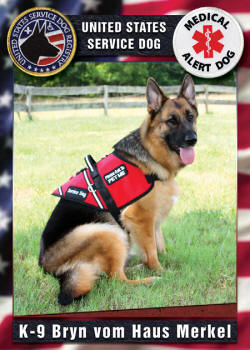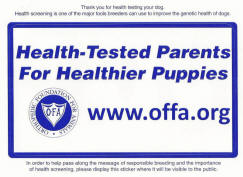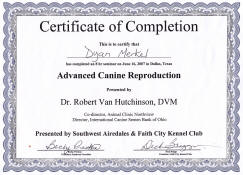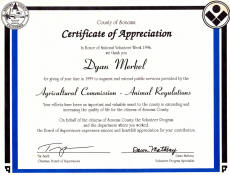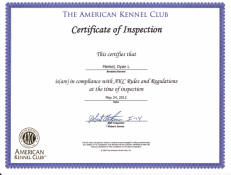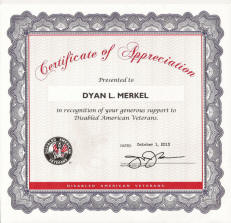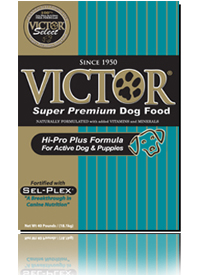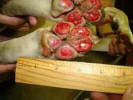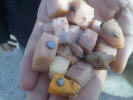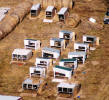|
Condition |
Description |
Symptoms |
Diagnosis |
Treatment |
|
Acanthosis nigricans |
Inherited form seen in Dachshunds; secondary
form caused by friction, hormonal abnormalities,
or hypersensitivities |
Darkening of the skin; in secondary form see
scratching and hair loss |
History, physical exam; in secondary form,
testing to determine underlying cause
|
Primary: no treatment; secondary: treat
underlying disease; in some cases, steroids and
Vitamin E supplementation |
|
Acral lick dermatitis (neurodermatitis) |
Self-licking in dogs results in self-trauma;
possible causes include anxiety, boredom, stress
(e.g., new member in household); licking can
develop into an obsessive behavior |
Red, hairless, well-circumscribed, sometimes
raised lesion usually on the leg; if chronic,
will drain |
Exclude other causes; history important |
Relieve underlying cause e.g., anxiety; restrict
licking, e.g.,
elizabethan collar; behavior
modifying medication may be necessary
|
|
Adrenal sex hormone responsive dermatosis |
More common in Pomeranians, Chows, Keeshonden,
and Samoyeds |
Hair loss starts on neck, tail, back of thighs,
and progresses to trunk; dog appears to have a
'puppy coat'; skin darkens |
Biopsy; eliminate other causes |
Mitotane is optional |
|
Allergic and irritant contact
dermatitis |
An allergic reaction following exposure to
antibiotics applied to the skin; metals such as
nickel; materials such as rubber, wool, and
plastic; and chemicals such as dyes and carpet
deodorizers; or inflammation caused by
irritating substances such as poison ivy.
Generally requires multiple exposures.
|
Red skin and small bumps or blisters on the
areas of skin that are sparsely haired and
directly exposed to the offending substance,
itching; hair loss in chronic conditions |
Patch test, exclusion trials |
Restrict exposure to the allergen or contact
irritant in the dog's environment; steroids,
antihistamines |
|
Alopecia areata |
Thought to be an autoimmune disorder |
Patches of hair loss especially on head, neck,
and body; no itching |
Microscopic examination of hairs; biopsy |
Usually recover spontaneously |
|
Atopy (allergic inhalant
dermatitis) |
Allergic reaction to something the dog inhales
such as pollen, house dust mites, and mold |
Licking of feet, inflamed ears, itching,
redness, and hair loss; sometimes development of
infection or hot spots |
Intradermal or serologic (blood)
testing for allergies |
Reduce exposure to allergen (what the dog is
allergic to); steroids,
fatty acid supplements,
biotin, antihistamines, shampoos,
immunotherapy |
|
Bacterial infection (pyoderma)
See Folliculitis |
Often occurs as a result of another condition
such as a parasitic, allergic, or hormonal
condition |
|
|
|
|
Black hair follicular
dysplasia/alopecia/dystrophy |
Rare hereditary disease in dogs with hair of
multiple colors; more common in Bearded Collies,
Basset Hounds, Salukis, Beagles, Dachshunds, and
Pointers |
Loss of dark or black hair only; symptoms appear
between 3 and 6 weeks of age; sometimes scaling |
Clinical signs, biopsy |
Shampoos for scaling if necessary |
|
Callus |
Results from chronic pressure, especially in
large breed dogs |
Thickened, hairless raised areas over bony
pressure points such as elbows; may become
secondarily infected |
History, clinical signs |
Provide softer bedding and padding around
affected area |
|
Castration responsive dermatosis |
More common in young unneutered dogs, and in
Chows, Samoyeds, Keeshonden, Alaskan Malamutes,
Miniature Poodles, and Pomeranians |
Symmetrical hair loss in genital area and neck;
hair loss may progress onto trunk; skin may
appear darker; severe scaling; hair color may
fade; coat is similar to a 'puppy coat' |
Physical exam and history; eliminate other
causes; blood tests for
hormone levels |
Castration |
|
Chemotherapy |
Loss of hair due to
chemotherapy is a concern for dog
owners |
Dogs with continuously growing hair, e.g.,
Poodles and Maltese, often lose some hair; dogs
may lose whiskers |
History |
None, hair will regrow after chemotherapy
discontinued; may regrow in a different color or
texture |
|
Cheyletiella
(rabbit fur mite) mange |
Infection with the Cheyletiella mite |
Itching,
scaliness; some hair loss, if
severe |
Skin scraping and microscopic examination - the
mite is often very difficult to find |
Pyrethrin,
Permethrin (Do NOT use permethrin
on cats.) |
|
Color dilution/mutant alopecia |
Hereditary condition affecting dogs with blue
(diluted black) or fawn coat colors; more common
in Dobermans, Dachshunds, Great Danes, Yorkshire
Terriers, Whippets, and Greyhounds |
Hair in the blue- and fawn-colored areas starts
to thin at around 6 months of age; secondary
folliculitis often develops |
Breed; history; and coat color |
None; avoid excessive grooming or harsh
shampoos; protect skin to prevent secondary
bacterial infections |
|
Congenital hypotrichosis |
Congenital lack of hair |
Puppies born with little or no hair; any hair
they are born with is lost by 4 months of age |
Physical exam; biopsy |
None |
|
Cushing's disease
(hyperadrenocorticism) |
Caused by an increase in corticosteroids in the
body - either due to increased production by the
body or as a side effect of high doses or
prolonged therapy with corticosteroids |
Hair loss, thinning of skin,
hyperpigmentation, easy bruising,
seborrhea, comedones (black heads), may see
calcinosis cutis; lethargy, increased thirst and
urination, potbellied appearance |
Adrenal gland function tests, urinalysis,
chemistry panel, CBC |
If due to glandular tumors, selegiline, o,p-DDD (Mitotane), or surgical
removal of tumor; if due to high steroid doses,
withdraw use of steroids slowly |
|
Cyclic (cicatrical) alopecia;
seasonal flank alopecia |
Growth cycle of hair stops at certain times of
the year |
Symmetrical hair loss with definite borders;
usually on back and flanks; skin may become
darker |
History, clinical signs, biopsy |
None |
Demodectic mange
(red mange, puppy
mange) |
Infection with the Demodex mite -
occurs when the immune system is deficient |
Hair loss,
scaliness, redness,
pustules,
ulcers, sometimes itching,
darkening of the skin |
Skin scraping and microscopic examination |
NO Steroids! Amitraz
(Mitaban) dips |
|
Dermatomyositis |
Some breeds predisposed; cause unknown;
aggravated by trauma and UV light |
Redness, scaling, crusting, hair loss, and scarring on face, ears, and
tail; atrophy of muscles involved in chewing |
Skin biopsy |
Minimize trauma and exposure to UV light;
Vitamin E, fatty acids, short term use of
prednisone, oxpentoxifylline; some severe cases
do not respond to treatment, and euthanasia may
be considered |
|
Diabetes mellitus |
Abnormal immunity makes diabetic dogs
susceptible to infection and other skin
conditions |
Thin skin; some hair loss; seborrhea; recurrent
bacterial infections; unregulated dogs also have
many other signs of disease; may develop
epidermal metabolic
necrosis or xanthoma |
Blood testing |
Dietary changes; insulin |
|
Drug or injection reaction |
Rare skin reaction to a drug which is inhaled,
given orally, or applied topically; more common with penicillins,
sulfonamides, and cephalosporins; usually occurs
within 2 weeks of giving the drug |
Can vary widely and may include itching, hair
loss, redness, swelling,
papules,
crusts,
ulcers, and draining wounds |
History of being treated with a drug, symptoms,
biopsy |
Discontinue offending drug; treat
symptomatically |
|
Epidermal metabolic necrosis
(necrolytic migratory erythema, hepatocutaneous
disease) |
Uncommon skin disease in older dogs; skin
lesions develop in dogs with certain diseases
including liver disease, diabetes mellitus, and
some pancreatic
tumors |
Reddened, often ulcerated areas with hair loss
and
crusts; foot pads may be thickened |
Biopsy; look for underlying disease |
Treat underlying disease; supportive therapy;
poor prognosis |
|
Erythema multiforme |
Hypersensitivity reaction to infections or
drugs; may also be caused by
cancer or other diseases |
Hair loss, 'bull's-eye' lesions, and
vesicles often around mouth, ears,
groin, and axilla;
in some instances,
ulcers develop; depression, fever |
History, clinical signs, rule out other diseases
causing similar signs; skin biopsy |
Treat or remove underlying cause |
|
Estrogen responsive dermatosis (ovarian
imbalance type II) |
More common in young spayed dogs, and in
Dachshunds and Boxers |
Hair loss starting at the genital area and
flanks and moving forward; hair color may fade;
coat is similar to a 'puppy coat' |
Physical exam and history; eliminate other
causes; response to therapy |
Estrogen replacement therapy; caution - can have
severe side effects |
|
Flea allergy dermatitis (flea
bite hypersensitivity) |
Severe reaction by the animal to the saliva of
the flea |
Intense itching, redness, hair loss
papules, crusts, and scales; sometimes development of infection or hot
spots |
Presence of fleas; reaction to intradermal testing |
Flea control in the environment and on the
dog; steroids and antihistamines for the itching |
|
Follicular
dystrophy/alopecia/dysplasia (abnormal
development or growth of hair)
See Congenital
hypotrichosis, Color dilution/mutant alopecia,
Black hair folliclular dystrophy/alopecia,
Follicular dysplasia (non-color linked) |
May be congenital (certain breeds are at
increased risk) or acquired later in life from
infections, hormonal abnormalities,
cancer
drugs, and some other diseases |
Hair loss, sometimes only hair of a certain
color; sometimes scaling |
Clinical signs, breed, skin biopsy |
In congenital disease, treatment of secondary
problems such as infections or scaling; in
acquired disease treat underlying cause |
|
Follicular dystrophy/dysplasia
(non-color linked) |
Patchy hair loss of unknown cause seen in the
Siberian Husky, Doberman Pinscher, Airedale,
Boxer, Staffordshire Bull Terrier, Curly Coated
Retriever, Irish Water Spaniel, and Portuguese
Water Dog |
In Huskies, hair loss on the body, reddish tinge
to hair; in Dobermans, hair loss over lumbar
area; in Boxers and Terriers, hair loss over
lumbar area, skin may be hyperpigmented; in the Retrievers and
Spaniels, loss of guard hairs on back and trunk
and secondary hairs are dull and lighter in
color |
Breed, biopsy |
None |
|
Folliculitis |
Infection of the hair follicles, often with staph bacteria; symptoms
usually appear on skin with less hair, such as
the abdomen |
Pustules form
in follicles and break open to form
'bull's-eye,' 'annular,' and 'target lesions,'
which have
crusty centers and red or
darkening on the periphery, and 'epidermal
collarettes,' which appear as rings of
scaly
skin; may itch; short-coated breeds may develop
small tufts of hair, which are lost; breeds with
long coats may have seborrhea |
Skin scraping; culture; biopsy |
Antibiotics for at least 4 weeks - continue
antibiotics 10 days beyond the apparent cure; if
recurs, look for underlying problem such as
allergy or hormonal imbalance |
|
Food allergies |
Allergic reaction to something in the diet |
Licking of feet, inflamed ears, itching,
redness, and hair loss; sometimes development of
infection or hot spots |
Food elimination trials |
Change in diet |
|
Granulomas |
May be due to infections; the body's reaction to
foreign material such as plant material (e.g.,
foxtail) and suture material; other constant
irritation; or unknown causes |
Solid firm nodules of varying sizes; those due to foreign
bodies often have draining tracts; may develop
hair loss,
ulcers, and
secondary infections |
History, clinical signs, biopsy, surgical
exploratory |
Surgical removal of the foreign body (in the
case of plant material, tracts may be extensive
and require major surgery); antibiotics if
infected; treat any other underlying cause |
|
Growth hormone responsive
alopecia |
Not well understood; thought to be caused by an
enzyme deficiency or decrease of adrenal
hormones, which allows certain other hormones to
accumulate in the body: more common in
Pomeranians, Chow Chows, Keeshonden, Samoyeds,
and Poodles |
Hair loss on neck, tail, and the back of the
thighs; skin darkens; usually starts when dog is
less than two years old |
Hormonal blood testing |
Neuter animal; growth hormone; hormonal
supplementation |
|
Hair loss during pregnancy and
nursing ('blowing her coat,'
telogen effluvium) |
Excess shedding that can also occur in other
stressful circumstances such as illness or
surgery |
Sudden and widespread hair loss |
History, clinical signs |
Treat any underlying condition; hair will grow
back |
|
Histiocytosis |
There are several kinds of histiocytosis:
malignant,
which is a cancer
that affects the skin and internal organs;
systemic, which is a rare disease which affects
skin and internal organs; and
cutaneous,
which is a benign
disease affecting the skin |
All cause nodules with hair loss; malignant and systemic also
have
ulcers |
Biopsy, fine needle
aspirate; |
Malignant: none effective, may need to consider
euthanasia; systemic: poor response to
chemotherapy; cutaneous: corticosteroids,
relapse is common, especially in Shar-Peis |
|
Hyperestrogenism (ovarian imbalance type I) |
Rare disease in which female animals have excess
levels of estrogen; can be caused by
cancer
of the ovaries |
Symmetrical loss of hair; hair pulls out easily;
darkening of the skin; enlarged nipples and
vulva; may rarely see seborrhea and itching |
History, physical exam, rule out other causes of
hair loss, measure blood estrogen levels |
Spay; look for
metastasis to the lungs |
|
Hypothyroidism |
Decreased production of thyroid
hormone;
most common hormonal disease affecting the skin
in dogs |
Hair loss, dry and brittle hair, seborrhea;
secondary bacterial and yeast infections;
lethargy, obesity, slow heart rate; changes in
skin pigmentation may occur |
Thyroid gland function tests, chemistry panel,
CBC |
Lifetime thyroid supplementation |
|
Injection site alopecia |
Hair loss at the site of an injection of a
medication or vaccine; skin may become
thickened; in cats,
ulcers may develop |
Hair loss occurs several months after injection;
area may become
hyperpigmented |
History and physical examination |
None; the condition is permanent |
|
Interstitial cell tumor |
Tumor
of the testicle; may not cause any skin changes |
If skin changes occur, see seborrhea, loss of
hair on the trunk, enlargement of the tail gland
and perianal glands; may see increased pigment
in the skin |
Biopsy |
Castration; anti-seborrheic shampoos |
|
Kerion |
Complication of ringworm infection |
Nodule
with hair loss and multiple draining tracts; may
not see other signs of ringworm |
Culture, biopsy |
Clip area and apply
topical treatment and shampoos;
may require systemic treatment with ketoconazole
or itraconazole |
|
Leishmaniasis |
Caused by a parasite of blood cells; can be
transmitted to people who develop a very severe
disease |
Hair loss, scaling, ulcers on nose and ears, sometimes
nodules;
many other nonskin-related signs |
Identify the organism in blood or biopsy; blood
tests |
Because it causes severe disease in people, and
treatment of dogs is not curative, euthanasia
may be performed |
|
Lice |
Infection with several species of lice |
Variable; itching, hair loss,
crusts, rough hair coat |
Finding lice or nits on skin or hair |
Pyrethrin,
ivermectin (off-label use*),
Permethrin (Do NOT use permethrin
on cats.) |
|
Malassezia |
Usually follows some other underlying disease |
Itching, redness, hair loss, greasy
scales; if chronic, develop
hyperpigmentation |
Skin scraping/smear and microscopic examination,
culture |
Treat underlying disease; oral ketoconazole;
miconazole shampoos |
|
Nasal solar dermatitis
See solar dermatitis |
See solar dermatitis |
|
|
|
|
Pattern alopecia (pattern
baldness) |
Three types; hair loss may occur on the ears of
Dachshunds (pinnal alopecia); neck, thighs, and
tail of American Water Spaniels and Portuguese
Water Dogs; abdomen and the back of the thighs
of Dachshunds, Chihuahuas, Whippets, and
Greyhounds |
Hair loss in described areas |
Breed, history, biopsy |
None |
|
Pelodera dermatitis |
Accidental infection with larvae from a
non-parasitic worm that lives in straw and other
organic material |
Affects areas of skin touching ground; intense
itching, redness, hair loss,
papules,
crusts, and scales |
Skin scraping and microscopic examination |
Remove bedding; mild antibacterial shampoo;
steroids if necessary to control itching |
|
Pituitary dwarfism |
Hereditary condition in which the pituitary
gland does not produce the necessary
hormones |
Young puppies fail to grow; dogs retain puppy
coat and condition progresses to hair loss over
much of the body; thin skin,
scales, and
secondary infections |
Special blood testing for the presence of
certain hormones |
Hormone replacement therapy |
|
Post-clipping alopecia |
Hair may not grow back immediately after it has
been clipped; which animals may be affected can
not be predicted; more common in dogs with thick
undercoats e.g., Huskies and Chows |
Continued lack of growth in hair that was
clipped, e.g., for surgery |
History |
None; hair will eventually regrow, but may take
up to 24 months |
|
Pressure sores (decubital ulcers) |
Lesions occur over bony prominences like elbows;
common in larger recumbent dogs |
Start as red, hairless areas and progress to
draining
ulcers; may become infected |
Clinical signs, biopsy |
Keep area clean and prevent contact with urine;
antibiotics; apply donut bandages, which provide
padding around but not over the ulcer; surgical
treatment is sometimes necessary; prevent ulcers
by turning the dog every 2 hours |
|
Pyoderma-superficial
(See Folliculitis) |
|
|
|
|
|
Ringworm |
Infection with several types of fungus |
Hair loss,
scaliness,
crusty areas,
pustules, vesicles, some itching; can develop a draining
nodule
called a 'kerion' |
Culture |
Miconazole, lime sulfur dips; oral
griseofulvin or itraconazole |
|
Sarcoptic mange |
Infection with the Sarcoptes mite |
Intense itching and self-trauma, hair loss,
papules, crusts, and
scales |
Skin scraping and microscopic examination - the
mite is often very difficult to find |
Amitraz (Mitaban) dips (off-label use*);
ivermectin (off-label use*) |
|
Schnauzer comedo syndrome |
Uncommon; only seen in Miniature Schnauzers |
Comedones (black heads) on back, mild itching;
may see secondary
infection, thinning of hair; small
crusts may develop |
Clinical signs, breed, skin biopsy |
Long-term antiseborrheic shampoos; sometimes
antibiotics and retinoids |
|
Sebaceous adenitis |
Sebaceous glands
are destroyed, cause unknown; certain breeds
more susceptible |
Short-haired breeds: circular areas of hair loss
with fine scale;
long-haired breeds: more widespread hair loss
and scale, hair mats easily; may see itching in
all breeds |
Clinical signs, breed, skin biopsy |
Antiseborrheic shampoos, fatty acid supplements;
in more severe cases, steroids, retinoids |
|
Seborrhea |
Can be primary (inherited) or secondary
(resulting from other disease processes such as
allergies, hypothyroidism) |
Scales; depending upon the type, may have a dry
or oily coat; odor; some scratching; may see
hair loss |
Blood tests, skin scrapings, etc., to find
underlying cause |
Treat underlying cause if present;
antiseborrheic shampoos; fatty acid supplements |
|
Sertoli cell tumor |
Tumor
of the testicles in middle-aged dogs |
Male dogs take on female sexual characteristics;
hair loss, increased skin pigment, reddened area
on prepuce |
Physical exam |
Castration |
|
Solar dermatosis |
Skin reaction to sunlight, especially
unpigmented skin; most common on the noses of
Collies, Shelties, and similar breeds |
Redness, hair loss, and scaling on nose and
ears, later
crusts and
ulcers |
History, breed, physical exam, skin biopsy |
Must avoid further sun exposure, especially 9 am
- 3 pm; sunblock; steroids; tattoo nose or apply
black ink |
|
Tail dock neuroma |
Nerve regrowth after tail docking causes
symptoms |
Nodule
at site of docking, itching with
self-mutilation, hair loss, and
hyperpigmentation |
History and symptoms |
Surgical removal |
|
Tail gland hyperplasia |
Dogs have a sebaceous
gland on the top of the tail near
its base; in this disorder, the gland enlarges;
seen in unneutered dogs and secondary to other
diseases such as hypothyroidism |
Oily area, hair loss, crusts, and
hyperpigmentation on area over
gland |
Clinical signs; look for underlying cause |
Castration may help; treat underlying cause;
surgical removal |
|
Testosterone responsive dermatosis (hypoandrogenism) |
More common in old neutered dogs, and in Afghans |
Dull, scaly, dry coat; seborrhea; hair loss in genital and
anal areas progressing onto trunk |
Physical exam and history; eliminate other
causes; response to therapy |
Testosterone replacement therapy |
|
Vitamin A responsive dermatosis |
May not be due to an actual deficiency of
Vitamin A, but does respond to increased levels
of Vitamin A in the diet; more common in Cocker
Spaniels |
Seborrhea; odor; hair pulls out easily; pads of
feet thickened; thick
scales on chest and abdomen,
especially around nipples |
Clinical signs, breed, skin biopsy |
Lifetime treatment with Vitamin A |
|
Zinc responsive dermatosis |
Three types: I in Huskies and Malamutes; II in
rapidly growing puppies of large breeds; III in
English Bull Terriers |
Crusting and
scaling, redness, hair loss, sometimes oily
skin, secondary bacterial infections common |
History, breed, physical exam, skin biopsy |
Correct any dietary deficiency, medicated
shampoos, treat
secondary infections |

